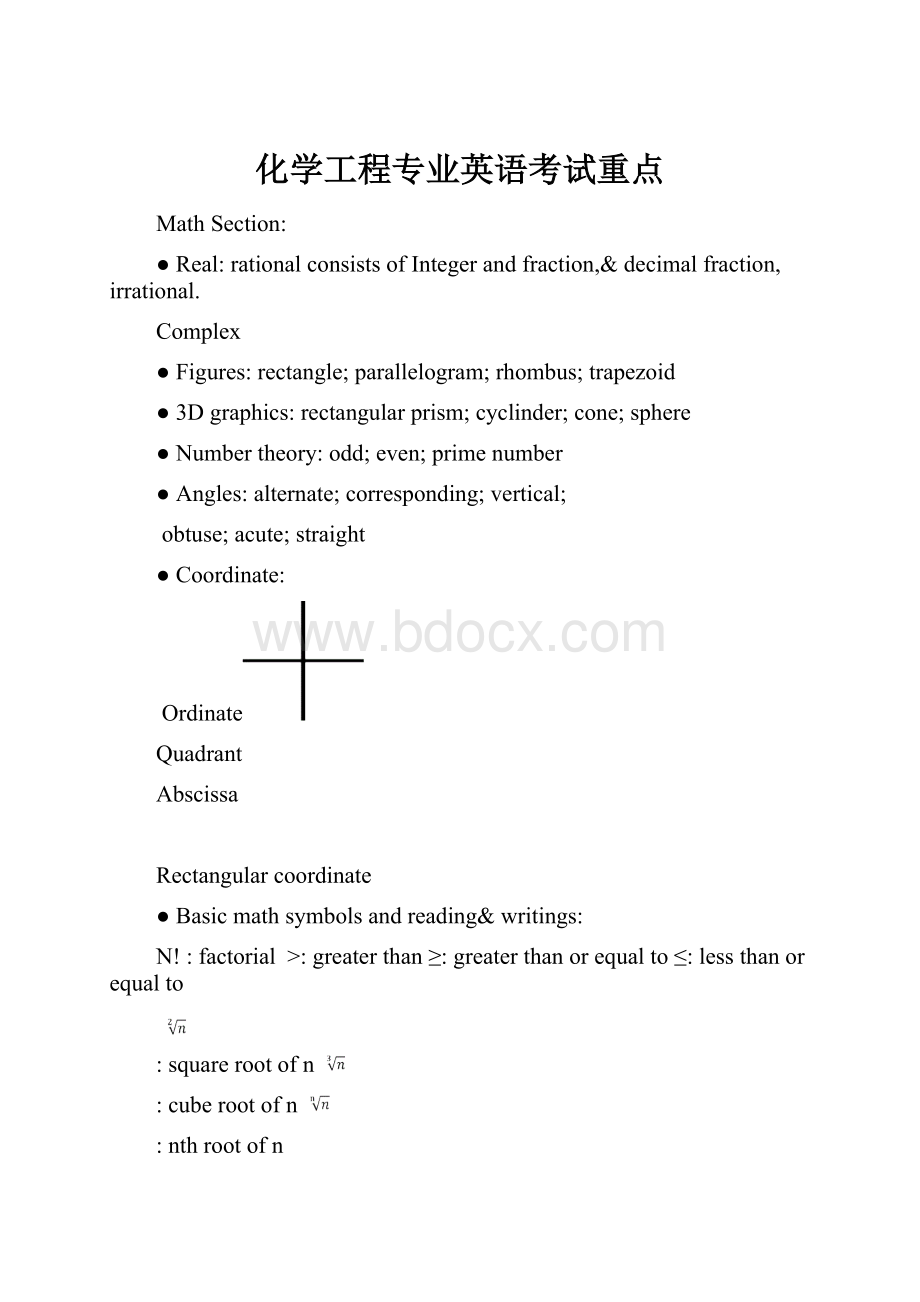化学工程专业英语考试重点.docx
《化学工程专业英语考试重点.docx》由会员分享,可在线阅读,更多相关《化学工程专业英语考试重点.docx(16页珍藏版)》请在冰豆网上搜索。

化学工程专业英语考试重点
MathSection:
●Real:
rationalconsistsofIntegerandfraction,&decimalfraction,irrational.
Complex
●Figures:
rectangle;parallelogram;rhombus;trapezoid
●3Dgraphics:
rectangularprism;cyclinder;cone;sphere
●Numbertheory:
odd;even;primenumber
●Angles:
alternate;corresponding;vertical;
obtuse;acute;straight
●Coordinate:
Ordinate
Quadrant
Abscissa
Rectangularcoordinate
●Basicmathsymbolsandreading&writings:
N!
:
factorial>:
greaterthan≥:
greaterthanorequalto≤:
lessthanorequalto
:
squarerootofn
:
cuberootofn
:
nthrootofn
ln(x):
naturallogarithmofxlog(x):
logarithmtothebase10ofx
loga(x):
logarithmtothebaseaofx|a|:
absolutevalueofa
xn:
thenthpowerofxx2:
thesquareofxdny/dxn:
thenthderivativeofytox
∂ny/∂xn:
thenthpartialderivativeofywithrespecttox
:
integralofywithrespecttox
:
integralofybetweenlimitsaandb
1,234,567,000:
onebillion,twohundredandthirty-fourmillion,fivehundredandsixty-seventhousand
PhysSection:
●Prefix:
●Otherunits:
Temperature:
Kelvin(K),Celsius(oC),Fahrenheit
Current:
ampere
Volume:
1cubicmeter=1liter
Force:
1N(Newton)=105dyne,1kgf=9.8N(Newton)
Pressure:
1atm(atmosphere)=101.325kPa,1kPa=7.5mmHg,1kPa=0.01bar
Thermal:
1J(Joule)=0.2389cal(calorie)
Power:
1kW(kilowatt)=1.34HP(horsepower)
Viscosity:
cp(centipoise)=mPa·s
Charge:
1Ah=3600C1As=1C(coulomb)
●TEM(Transmissionelectronmicroscopy):
TEMsamplesofsilvernanoparticleswerepreparedbyplacingadropofsilverhydrosoloncarboncoatedcoppergridsandallowingwatertocompletelyevaporate.High-resolutionTEMimageswereobtained,andenergydispersiveX-ray(EDX)analysiswasperformedonTecnaiF30microscope(FEI,TheNetherlands).
●SEM(scanningelectronmicroscope):
Atypeofelectronmicroscopethatproducesimagesofasamplebyscanningitwithafocusedbeamofelectrons.
●FTIR(Fouriertransforminfraredspectroscopy):
Itcoversarangeoftechniques,mostlybasedonabsorptionspectroscopy.Aswithallspectroscopictechniques,itcanbeusedtoidentifyandstudychemicals.
●Howtopredictmotioninrelativity:
E=mc2,WhereEistheenergyinJ,misthemassinkg,andcisthelightspeedinm/s.
●Coulomb’slaw:
F=Kq1q2/r2,WhereFistheelectricalforceinN,KisaconstantequaltoK=8.99*109Nm2/C2,qiisthechargeofparticleiinC,andristhedistanceofthetwoparticlesinm.
●Ohm’sLaw:
R=V/I,WhereRistheresistanceinOhm(Ω),Visthevoltageinvolt,andIisthecurrentinA.
●TheSchrodingerequation:
HΦ=EΦ,WhereHistheHamiltonianoperator,Φisthewavefunctionwhichcharacterizesparticle’smotion,andEistheenergyofparticleinJ.
ChemistrysectionⅠ(inorganic)
Onthemicroscopiclevel,matterconsistsofatomsandmolecules
●Periodictable
H
hydrogen
He
helium
Li
lithium
Be
beryllium
B
boron
C
carbon
N
nitrogen
O
oxygen
F
fluorine
N
neon
Na
sodium
Mgmagnesium
Al
aluminium
Si
silicon
P
phosphorus
S
sulfur
Cl
chlorine
Ar
argon
K
potassium
Ca
calcium
Sc
scandium
Ti
titanium
V
vanadium
Cr
chromium
Mn
manganese
Fe
iron
Co
cobalt
Ni
nickel
Cu
copper
Zn
zinc
Ga
gallium
Ge
germanium
As
arsenic
Se
selenium
Br
bromine
Kr
krypton
Rb
rubidium
Sr
strontium
Y
yttrium
Zr
zirconium
Nb
niobium
Mo
molybdenum
Tc
technetium
Ru
ruthenium
Rh
rhodium
Pa
palladium
Ag
silver
Cd
cadmium
In
indium
Sn
tin
Sb
antimony
Te
tellurium
I
iodine
Xe
xenon
Cs
caesium
Ba
barium
La
lanthanum
Ce
cerium
Pr
praseodymium
Nd
neodymium
●Chemicalbondistheforcewhichholdstogetheratomsinmoleculesorcrystals–ionicbond,covalentbond,coordinationbond,hydrogenbond(?
),metallicbond.
●Polymerconsistsofplastic(resin),fiber,rubber.Apolymerisalong,repeatingchain
ofatoms,formedthroughthelinkageofmanyidenticalmoleculescalledmonomers.
Polymerhasrepetitionofmonomersbecauseofpolymerization.
●Matterstates:
gas,liquid,solid.
●Puresubstancesormixtures
Ifmatterisnotuniformthroughout,thenitisaheterogeneousmixture.
Ifmatterisuniformthroughout,itishomogeneous.
Ifhomogeneousmattercanbeseparatedbyphysicalmeans,thenthematterisa
mixture.
Ifhomogeneousmattercannotbeseparatedbyphysicalmeans,thenthematterisa
puresubstance.
Ifapuresubstancecanbedecomposedintosomethingelse,thenthesubstanceisa
compound.
Ifapuresubstancecannotbedecomposedintosomethingelse,thenthesubstanceisanelement.
Thereare114elementsknown.
●Solution(usuallytransparent),colloids(milkorpanits)andgrains(somematerials).
●Atoms:
Allmatterismadeupoftinyparticlescalledatoms.
Molecules:
Sometimestwoormoreatomsarefoundboundtogethertoform
molecules.
Elementsaremadeupofonlyonetypeofatom.
●Threebasicparticles:
protons,electrons,andneutrons,protonsandneutrons
combinetobenucleus
●Sometimesanatomcanhavemoreorfewerelectronsthanprotonsresultinginanetpositiveornegativecharge.Whenthishappensitiscalledanion.
●Isotopes:
atomswiththesamenumberofprotonsbutdifferentnumbersofneutrons.
Nomenclatureofinorganiccompounds
●-ide:
CuCl:
copper(I)chloride/cuprouschloride
CuCl2:
copper(Ⅱ)chloride/cuprouschloride
FeBr2:
Iron(Ⅱ)bromide/ferrousbromide
Fe2O3:
Iron(Ⅲ)oxide/ferricoxide
Fe3O4:
ferroferricoxide
●-ate(ite)
ClO4-(perchlorate),ClO3-(chlorate),ClO2-(chlorite)ClO-(hypochlorite)
HCO3-(hydrocarbonate),CO32-(carbonate)
SO42-(sulfate),SO32-(sulfite)
HPO42-(hydrogenphosphate),PO43-(phosphate),H2PO4-(dihydrogenphosphate)
CrO42-(chromate),Cr2O72-(dichromate)
NO3-(nitrate),MnO4-(permanganate)OH-(hydroxide)
suffixes:
ate(higheroxidationstate),ite(lower…)
_prefixes:
per(highestoxidationstate),hypo(lowest…)
Someexamples:
Na2SiO3Sodiumsilicate
Na2Al2O4Sodiumaluminate
NaBH4Sodiumborohydride
●-ic,-ous(acids)
Someacids:
(shape–ateinto–ic,shape–iteinto–ous)
HClO4(perchloricacid),HClO3(chloricacid),HClO2(chlorousacid),HClO(hypochlorousacid)
HCl:
hydrochloricacid
H2SO4:
sulfuricacid
HNO3:
nitricacid
H3PO4:
phosphoricacid
●Someprefixes
CO2(Carbondioxide)CO(Carbonmonoxide)CCl4(Carbontetrachloride)
CCl3(Carbontrichloride)
Sequence:
mon(o),di,tri,tetr(a),pent(a),hex(a),hept(a),oct(a)
[Cr(NH3)4Cl2]Cl2:
dichloro-tetrammine-chromium(IV)chloride
●aprocesswherebyatoms,groupsofatoms,orionsloseelectronsiscalledoxidation;whilstaprocesswherebythesegainelectronsiscalledreduction.
ChemistrysectionⅡ(organic)
●Prefixes:
1-10:
meth(a),eth(a),prop(a),but(a),pent(a),hex(a),hept(a),oct(a),non(a),deca
●Suffixes
Alkylgroups:
methyl,ethyl,propyl,butyl,pentyl,phenyl
Alkoxylgroups:
hydroxyl)(-OH),methoxyl(-CH3),carboxyl(coo-),carbonyl(c=o),
●Nomenclatureoforganiccompounds
●Alkanes(-ane):
prefix+ane
●Alkenes(-ene):
prefix+ene
●Alkynes(-yne):
prefix+yne
●Alcohols(anol,enol,ynol)
●Aldehyde(anal,enal,ynal)
●Ketones(anone,enone,ynone)
●Benzene/phenols:
Para(对),ortho(邻),andmeta(间)positionsonthebenzenering.
●Ethers:
Iftheoxygenisinaring,use‘epoxy’asaprefix.
●Alkylhalides:
Theyhaveprefixesasmono,di,tri,tetra.
●Carboxylicacids:
e-oicacid.
ChemistrysectionⅣ(physicalchemistry)
●Chemicalthermodynamicsconcernswithenergychangeandthetrendofequilibriumandtheequilibriumstate.
Chemicalkineticsconcernswiththerateofmatterchange,alsobeseenasreactionrate.
●Internalenergy:
U(motions,interactions,andbondingofitsconstituentmolecules)
Externalenergy:
kinetic+potentialenergy
Thermalenergy:
internalenergy+heat
Mechanicalenergy:
externalenergy+mechanical/electricalwork
Heat:
Qtemperaturedifference
Work:
Wmechanicalmotion
●Intermolecularforces:
attractive,repulsive,specific
●Thezerothlawofthermodynamics:
iftwosystemsareinthermalequilibriumwithathirdsystem,theyarealsointhermalequilibriumwitheachother.
●PVTrelations:
PV=nRT,wherePisthepressureinPa,Visthevolumeinm3,nisthemoleculesinmol,RisthegasconstantequaltoR=8.314Pa·m3/(mol·K),TisthetemperatureinK.
●Thefirstlawofthermodynamics:
Thetotalenergyofasystemplusitssurroundingsremainsconstant.Energycannotbecreatedordestroyed,onlymodifiedinforms
●Thesecondlawofthermodynamics:
Itisnotpossibletoconstructadevicethatoperatesinacycleandwhosesoleeffectistotransferheatfromacolderbodytoahotterbody.Itisimpossibletoconstructadeviceoperatinginacyclethatresultsinnoeffectotherthantheproductionofworkbytransferringheatfromasinglebody.
●Theentropy(S)ofanisolatedsystemincreasesinaspontaneous(irreversibleornatural)change.
Forareversibleprocess,thechangeofentropyisdS=Qr/T
Foranirreversibleprocess,thechangeofentropydS=Q/T+Sgen
Carnotcycle:
●1.Reversibleisothermalexpansionofthegasatthe"hot"temperature,T1(isothermalheatadditionorabsorption).
●2.Isentropic(reversibleadiabatic)expansionofthegas(isentropicworkoutput).
●3.Reversibleisothermalcompressionofthegasatthe"cold"temperature,T2.(isothermalheatrejection)
●4.Isentropiccompressionofthegas(isentropicworkinput).
●Thethirdlawofthermodynamics:
Itisimpossibletoattainatemperatureofabsolutezero.Theentropiesofallsubstancesintheperfectcrystallineortheperfectliquidstatearezeroattheabsolutezerooftemperature(0K).
●Perfectstate:
withoutanydisturbanceinthearrangementoftheatoms.
●Heatof